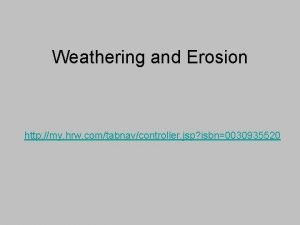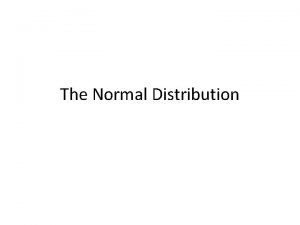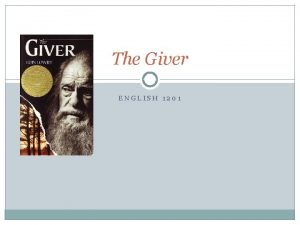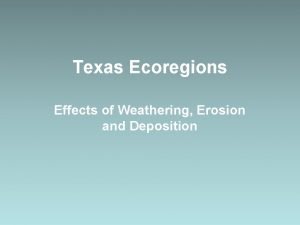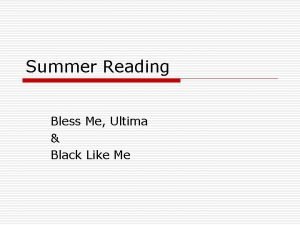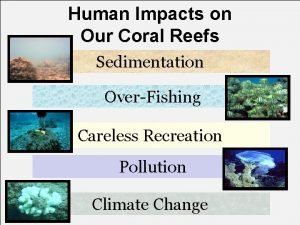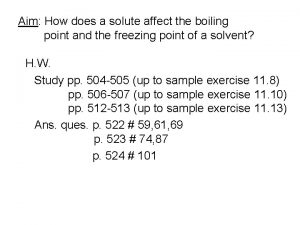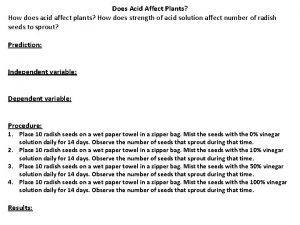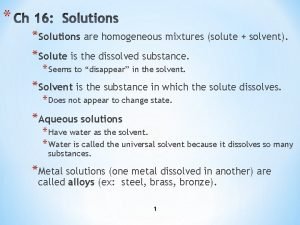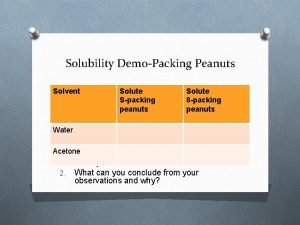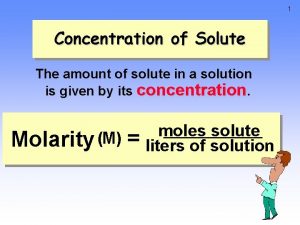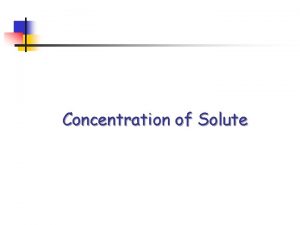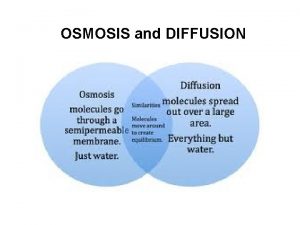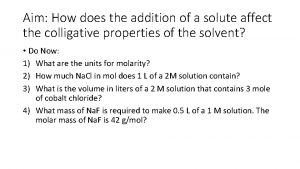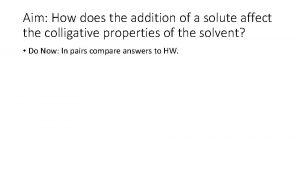Aim 46 How does a solute affect the












- Slides: 12

Aim # 46: How does a solute affect the vapor pressure of a solvent? H. W. # 46 Study pp. 521 – 526(sec. 11. 4) Ans. ques. p. 521 # 51, 54, 59, 64

I Vapor pressure is the pressure exerted by vapor that is in dynamic equilibrium with its liquid (in a closed system). pure solvent solution with a nonvolatile solute Vsolvent = Vsolution

II Raoult’s law Where PA = vapor pressure of the P A = χ P A 0 solution (solvent) χA = mole fraction of the solvent PA 0 = vapor pressure of the pure solvent solution vapor pressure PA mole fraction of solvent 1 χA Vapor pressure depression is proportional to the concentration of solute particles. 0

Problem: Urea, (NH 3)2 CO, has practically no vapor pressure at ordinary temperatures. The vapor pressure of pure water at 30. 0 C is 31. 824 torr. A solution contains 50. 0 g urea and 1000. g H 2 O. Find the vapor pressure of this solution at 30. 0 C. Ans: nurea = 50. 0 g x 1 mol =. 833 mol 60. 0 g n. H 20 = 1000. 0 g x 1 mol = 55. 555 mol 18. 0 g PH 20 = χH 20 P 0 H 20 PH 20 = 55. 555. 833 + 55. 555 x 31. 824 torr = 31. 354 torr The vapor pressure is lower by 0. 470 torr.

Problem: The vapor pressure of pure ethanol at 63. 50 C is 400. torr. When 15 g of an unknown, non-volatile solute is dissolved in 92. 136 g of ethanol, the vapor pressure of the resulting solution is 380 torr. What is the molar mass of the solute? Ans: PEt. OH = χEt. OHP 0 Et. OH χEt. OH = PEt. OH = 380 torr =. 950 P 0 Et. OH 400 torr n. Et. OH = 92. 136 x 1 mol = 2. 0000 mol 46. 068 g ntotal = 2. 0000 = 2. 105 mol. 950 nsolute = 2. 105 – 2. 0000 =. 105 molar mass = 15 g 1 mol. 105 molar mass = 142. 9 g = 140 g

III The vapor pressure of a solution with an ionic solute vapor pressure α concentration depression of solute In solution Na. Cl(aq) → Na+(aq) + Cl-(aq) For a 1. 0 M Na. Cl solution, the number of moles/liter of solute particles is actually 2. 0. For glucose(1. 0 M) For Na. Cl(1. 0 M) XH 2 O = n. H 2 O χH 2 O = n. H 2 O nglucose + n. H 2 O 2 n. Na. Cl + n. H 2 O Since PA = χAP 0 A , the ionic solute depresses the vapor pressure more.

IV Solutions that obey Raoult’s law exactly are called ideal solutions. Forces between solvent(A) and solute(B) particles A↔A, B↔B ≈ A↔B A↔A, B↔B < A↔B A↔A, B↔B > A↔B Deviation from Raoult’s law none(ideal solution) P A↓ (neg. deviation) example hexane pentane ethanol water P A↑ (pos. deviation) ethanol hexane


Solutions whose vapor pressures deviate from Raoult’s law are nonideal solutions. V Solutions of two volatile liquids (e. g. n-butane and n-pentane) Total vapor pressure = sum of the partial pressures PT = PA + PB = χAPA 0 + χPB 0 Problem: At 250 c, the vapor pressure of n-butane, C 4 H 10, is 1823 torr. The vapor pressure of n-pentane, C 5 H 12, is 521 torr. Assume that solutions of these two compounds are ideal.

a) Find the total vapor pressure at 250 c of a 100. 0 g solution containing 10% n-butane and 90% n-pentane (m/m). Ans: 10. 0 g n-butane x 1 mol =. 172 mol 58. 12 g 90. 0 g n-pentane x 1 mol = 1. 25 mol 72. 146 g χn-butane =. 172 =. 121. 172 + 1. 25 χn-pentane = 1. 25 =. 879. 172 + 1. 25 PT = (. 121)(1823 torr) + (. 879)(521 torr) PT = 679 torr

b) What is the mole fraction of the butane in the vapor? Ans: From Dalton’s law of partial pressures, Pn-butane = nn-butane = (. 121)(1823 torr) PT n. T 679 torr =. 325 c) Find the mole fraction of n-butane in a n-butane-n-pentane solution having a total vapor pressure of 760 torr at 250 C. Hint: χn-pentane = 1 – χn-butane

Ans: PT = 760 = χb. Pb 0 + χp. Pp 0 760 = χb. Pb 0 + (1 – χb)Pp 0 760 = χb. Pb 0 + Pp 0 – χb. Pp 0 760 = χb(1823) + 521 – χb(521) solving for χb , χb = 760 – 521 =. 184 1823 – 521 Additional Problems: Zumdahl (8 th ed. ) p. 523 # 99 p. 521 # 52, 57, 58, 60, 63
 Llano uplift weathering
Llano uplift weathering How does ice affect weathering
How does ice affect weathering How does water potential affect osmosis
How does water potential affect osmosis Nutrient cycle of a tropical rainforest
Nutrient cycle of a tropical rainforest Romeo and juliet context
Romeo and juliet context What is tragedy
What is tragedy How does the sun affect tides
How does the sun affect tides How does changing the mean affect a normal curve
How does changing the mean affect a normal curve The plot of the giver
The plot of the giver Piney woods
Piney woods How does weathering affect plains
How does weathering affect plains Bless me ultima reading level
Bless me ultima reading level Does overfishing affect coral reefs
Does overfishing affect coral reefs

